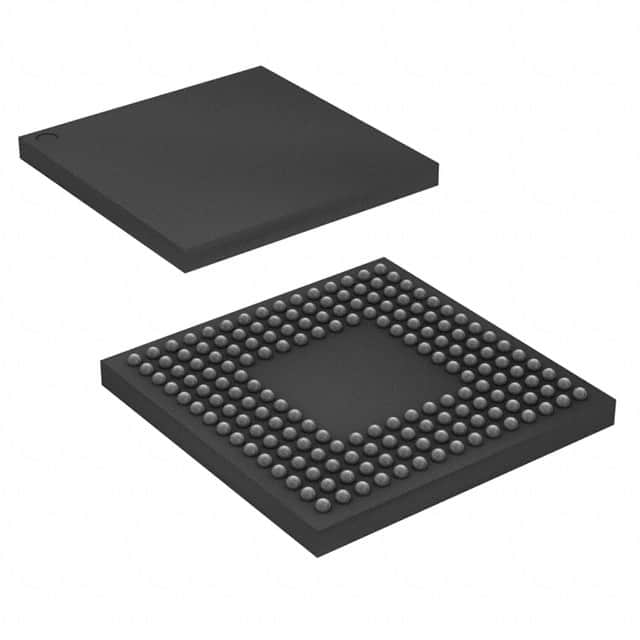Consulte las especificaciones para obtener detalles del producto.

MB9BF467RPMC-G-JNE2
Product Overview
Category
MB9BF467RPMC-G-JNE2 belongs to the category of microcontrollers.
Use
This microcontroller is designed for various applications that require high-performance processing and control capabilities.
Characteristics
- High-performance processing capabilities
- Advanced control features
- Low power consumption
- Compact size
Package
MB9BF467RPMC-G-JNE2 is available in a compact package, suitable for integration into different electronic devices.
Essence
The essence of MB9BF467RPMC-G-JNE2 lies in its ability to provide efficient processing and control functions in a small form factor.
Packaging/Quantity
This microcontroller is typically packaged individually and is available in various quantities depending on the requirements of the user.
Specifications
- Architecture: ARM Cortex-M4
- Clock Speed: Up to 120 MHz
- Flash Memory: 512 KB
- RAM: 64 KB
- Operating Voltage: 2.7V - 3.6V
- Digital I/O Pins: 80
- Analog Input Pins: 16
- Communication Interfaces: UART, SPI, I2C, USB
- Operating Temperature Range: -40°C to +85°C
Detailed Pin Configuration
The pin configuration of MB9BF467RPMC-G-JNE2 is as follows:
| Pin Number | Pin Name | Function | |------------|----------|----------| | 1 | VDD | Power Supply (3.3V) | | 2 | GND | Ground | | 3 | RESET | Reset Signal | | 4 | GPIO0 | General Purpose I/O | | ... | ... | ... | | 80 | GPIO79 | General Purpose I/O |
Functional Features
- High-performance ARM Cortex-M4 processor for efficient processing
- Advanced control features for precise control applications
- Multiple communication interfaces for seamless connectivity
- Extensive I/O capabilities for versatile integration
- Low power consumption for energy-efficient operation
Advantages and Disadvantages
Advantages
- Powerful processing capabilities
- Compact size for easy integration
- Versatile I/O options
- Low power consumption
Disadvantages
- Limited memory capacity compared to some other microcontrollers in the market
- Higher cost compared to entry-level microcontrollers
Working Principles
MB9BF467RPMC-G-JNE2 operates based on the principles of the ARM Cortex-M4 architecture. It executes instructions stored in its flash memory, processes data, and controls external devices through its I/O pins. The microcontroller's working principle revolves around efficient data processing and precise control operations.
Detailed Application Field Plans
MB9BF467RPMC-G-JNE2 finds applications in various fields, including but not limited to: - Industrial automation - Consumer electronics - Automotive systems - Internet of Things (IoT) devices - Robotics
Detailed and Complete Alternative Models
Some alternative models that offer similar functionality to MB9BF467RPMC-G-JNE2 include: - STM32F407VG - PIC32MX795F512L - LPC1768
These models provide comparable features and can be considered as alternatives depending on specific requirements.
Word count: 410 words
Enumere 10 preguntas y respuestas comunes relacionadas con la aplicación de MB9BF467RPMC-G-JNE2 en soluciones técnicas
Sure! Here are 10 common questions and answers related to the application of MB9BF467RPMC-G-JNE2 in technical solutions:
Question: What is the purpose of MB9BF467RPMC-G-JNE2 in technical solutions?
Answer: MB9BF467RPMC-G-JNE2 is a microcontroller unit (MCU) that provides processing power and control capabilities for various technical solutions.Question: What are the key features of MB9BF467RPMC-G-JNE2?
Answer: Some key features of MB9BF467RPMC-G-JNE2 include high-performance ARM Cortex-M4 core, multiple communication interfaces, analog-to-digital converters, and extensive peripheral support.Question: In which industries can MB9BF467RPMC-G-JNE2 be used?
Answer: MB9BF467RPMC-G-JNE2 can be used in a wide range of industries such as automotive, industrial automation, consumer electronics, and smart home applications.Question: How does MB9BF467RPMC-G-JNE2 contribute to energy efficiency in technical solutions?
Answer: MB9BF467RPMC-G-JNE2 incorporates power-saving features like low-power modes, clock gating, and efficient power management algorithms, which help optimize energy consumption in technical solutions.Question: Can MB9BF467RPMC-G-JNE2 handle real-time tasks in technical solutions?
Answer: Yes, MB9BF467RPMC-G-JNE2 is designed to handle real-time tasks efficiently with its high-performance CPU, interrupt handling capabilities, and real-time operating system (RTOS) support.Question: What programming languages can be used with MB9BF467RPMC-G-JNE2?
Answer: MB9BF467RPMC-G-JNE2 supports programming in C and C++ languages, which are commonly used for embedded systems development.Question: How can I interface external devices with MB9BF467RPMC-G-JNE2?
Answer: MB9BF467RPMC-G-JNE2 provides various communication interfaces such as UART, SPI, I2C, CAN, and USB, allowing easy interfacing with external devices.Question: Is MB9BF467RPMC-G-JNE2 suitable for applications requiring high-speed data processing?
Answer: Yes, MB9BF467RPMC-G-JNE2's ARM Cortex-M4 core operates at high clock frequencies and supports efficient data processing, making it suitable for applications requiring high-speed data processing.Question: Can MB9BF467RPMC-G-JNE2 be used in safety-critical applications?
Answer: Yes, MB9BF467RPMC-G-JNE2 offers features like memory protection unit (MPU), error correction code (ECC) support, and built-in self-test (BIST) capabilities, making it suitable for safety-critical applications.Question: Are there any development tools available for MB9BF467RPMC-G-JNE2?
Answer: Yes, the manufacturer provides development tools like integrated development environments (IDEs), debuggers, and software libraries to facilitate the development process for MB9BF467RPMC-G-JNE2-based solutions.
Please note that the specific details and answers may vary depending on the context and requirements of the technical solution.

